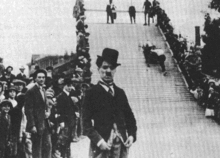Kid Auto Races at Venice
| Kid Auto Races at Venice | |
|---|---|
 Theatrical poster for Kid Auto Races at Venice (1914) | |
| Directed by | Henry Lehrman |
| Written by | Henry Lehrman |
| Produced by | Mack Sennett |
| Starring |
|
| Cinematography | |
| Distributed by | Keystone Studios |
Release date |
English (Original titles) |
Kid Auto Races at Venice (also known as The Pest) is a 1914 American film starring Charles Chaplin. It is the first film in which his "Little Tramp" character makes an appearance before the public. The first film to be produced that featured the character was actually Mabel's Strange Predicament; it was shot a few days before Kid Auto Races but released two days after it; this film, meanwhile, was released only five days after the first film in which Chaplin appeared, Making a Living. Kid Auto Races was inducted into the National Film Registry by the Library of Congress on December 14, 2020.[2]
Plot

Made by Keystone Studios and directed by Henry Lehrman, the movie portrays Chaplin as a spectator at a "pushcar"[3] race in Venice, Los Angeles. The film was shot during the Junior Vanderbilt Cup,[3] an actual race with Chaplin and Lehrman improvising gags in front of real-life spectators.
The film is presented at first like a genuine newsreel, with Chaplin's attention-seeking spectator getting in the way of the camera, causing great frustration to the cameraman. Lehrman begins by roughly pushing an obnoxiously persistent Chaplin away, but eventually he starts knocking Chaplin to the ground.[4]
Unusually, the camera breaks the fourth wall to show a second camera filming (as though it were the first) in order to better explain the joke. At this stage, Chaplin gets in the way only of the visible camera on screen, not the actual filming camera. In this way, the filming camera takes on a spectator's viewpoint, and Kid Auto Races becomes one of the first public films to show a movie camera and cameraman in operation.[4]
Cast
- Charlie Chaplin – The Tramp
- Henry Lehrman – Film Director
- Frank D. Williams – Cameraman
- Gordon Griffith – Boy
- Billy Jacobs – Boy
- Charlotte Fitzpatrick – Girl
- Thelma Salter – Girl[5][a]
Reviews
In the year that the film was released, a reviewer from the silent movie periodical Bioscope wrote, "Some sensational happenings are witnessed during the contests between the baby cars, while the funny man persistently obstructs the eager cameramen in their operations."[7] A reviewer from the silent movie periodical The Cinema noted, "Kid Auto Races struck us as about the funniest film we have ever seen. When we subsequently saw Chaplin in more ambitious efforts, our opinion that the Keystone Company had made the capture of their career was strengthened. Chaplin is a born screen comedian; he does things we have never seen done on the screen before."[7]
Junior Vanderbilt Cup
By 1914, the
See also
Notes
References
- ^ Mostrom, Anthony (June 19, 2011). "Unsuspecting extras go down in film history". Los Angeles Times.
- ^ Zongker, Brett. "National Film Registry Spotlights Diverse Filmmakers in New Selections". Library of Congress. Retrieved 14 December 2020.
- ^ a b c d Edmonds, Harvey (May 1914). "The 'Kids' Race". The Technical World Magazine: 394–395.

- ^ ISBN 0810945320.
- ^ Huff, Theodore, and Charlie Chaplin (1945). An index to the films of Charles Chaplin. British Film Institute.
- ^ "2. Kid Auto Races (1914)". BFI. 20 September 2006. Charlie Chaplin. Archived from the original on June 23, 2006. Retrieved 2015-03-16.
- ^ a b McDonald, Gerald D.; Conway, Michael; Ricci, Mark (1965). The Films of Charlie Chaplin. New York: Citadel Press, page 28.
External links
 Media related to Kid Auto Races at Venice at Wikimedia Commons
Media related to Kid Auto Races at Venice at Wikimedia Commons The full text of Kid Auto Races at Venice at Wikisource
The full text of Kid Auto Races at Venice at Wikisource- Kid Auto Races at Venice at IMDb
- Kid Auto Races at Venice at Rotten Tomatoes
- Kid Auto Races at Venice is available for free viewing and download at the Internet Archive
- Kid Auto Races at Venice is available for free viewing and download at the Internet Archive – A different version which is missing the ending.
